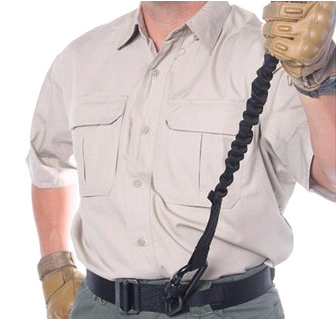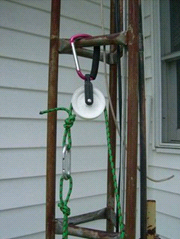Tower-Party Safety by Dale Kubichek N6JSX /8
The ultimate achievement, the status flag, the pinnacle of being a HAM is when you operate from your own tower. Whether the tower is to raise the apex of a HF inverted V, obtaining increased repeater/ATV distance, or optimize HF beam antenna height – height will improve your ability to make contacts.
This article is not about lightning nor grounding, this article is about YOU a HAM that has little to NO background in tower climbing or antenna installing – the classic out-of shape nerd that thinks he can do anything and will try to prove it. But all too soon you will learn the perils of heights when hanging from the tower for needless hours while attempting to install a tower section, antenna, rotor, or other items to discover you’re missing a part or tool. Then the ground crew is sent scurrying about seeking what is needed to make the tower-party evolution a success while you hang aloft – is that SAFE?
When it comes to having a successful tower-working-party, it is ALL in the planning, planning of each mundane detail with contingencies, alternatives, or enough information to call a delay until all is right! The number one goal to ALL tower-parties is to achieve SAFE success. The tower owner will lead or designate a leader that needs to create a written tower-party PLAN (a script) for all in the tower-party to reference. Write the PLAN like a choreographed NASA step-by-step space mission.
In the PLAN, do not bite off more than you can chew – plan to complete only one task per tower-party. Consider yourself lucky (or well prepared/experienced) if you’re able to get to task number two before the tower climbers must come down. ThePLAN needs to be written breaking out each task. ONLY progress to the next task when all agree (including climbers)! Party Chief remain aware of your climber’s fatigue while aloft – talk to them often to judge their state, but try not to frustrate them too much as they need to focus on the job at hand!
A good PLAN will select a cooperative and talented ground crew! Tower items should be pre-group on the ground for ease of access, pre-assembly, pre-tuning, and to insure all mounting hardware is present and kitted. Then insure you have the right tools for the job – double check everything ‘before’ the climb!
Just before the climb the Party Chief, Lead Climber and Ground Commander ‘shall’ conduct a party SAFETY briefing and verbally read the PLAN to the party (as a walkthrough) answering all questions NOW – not later – before anyone climbs. Insure everyone in the ‘party’ is thinking alike! Anyone in the tower- party can yell “)STOP)” if any safety hazard is spotted at any time (in this, all are EQUAL)! Make NASA proud – lives may depend on your eyes and actions.
The biggest uncontrollable factor to any tower-party is the “WEATHER!” COMMON- SENSE rules the day on this subject! If you decide to climb a tower with rain or thunderstorms near, I’ll read about you getting a Darwin award. Remember, lightening can strike even in clear skies up to 20 miles in front of a storm. But when it comes to tower work the unrealized killer is WIND, wind will swiftly fatigue even the most fit tower monkey (climber) with sun beating HEAT running a close second. If you climb with wind chills below freezing you deserve a Darwin award!
Topics for the tower PLAN: (but not all inclusive)
Purpose/leaders:
Tower build/repair – tasks #…
Rotor placement/repair – tasks #…
Antenna placement/repair – tasks #…
Annual maintenance inspection/repair – tasks #…
Who’s the tower-party Chief that makes all the calls: _call sign
Who’s the lead Climber who makes all calls aloft: _call sign
Who’s the ground Commander who makes all calls below: _call sign
Weather:
Season temperature – expected OP window hi:___ lo:___
Season winds – expected OP max:____mph
Season wind direction – no go direction:____
Season sun/rain/lightening/snow/ice/fog/etc
Emergency:
Site electrical/telephone wires – proximity safety review
Who will administer: _call sign(s)
First aid
CPR
911 – who will make the call: _call sign
Tower:
Climbers – abilities/experience/stamina
Climber’s harness/Carabineer/belt/hooks/ropes (safety inspection)
Gin pole & ropes
Rotor, cable, brackets, hardware, sealant
Tower parts/hardware
Tools:
Ladder (if used, pre-use safety inspection)
Common multi-purpose hand tools/wrenches
Special tools need/availability/how used
Tape/tie-wrap/lubricant/grease/etc.
Tender bucket for Tools/H2O/etc w/hoisting rope
Antenna #1:
A detailed list of hoisted assembles & discrete support hardware
Pre-assembled & adjusted (on the ground)
Verify all mounting hardware is present / kitted
Coax & connectors
Order of hoisting / tower placement (insure within climbers reach)
Mag or True North – how aligned
Antenna #2, #3…:
Same as Antenna #1
What if’s:
Missing / dropped / lost hardware contingency plan?
Who on Ground team assigned to run for hardware?
Tower-Party items to consider:If you’re erecting a tower or hoisting more than 25 lbs onto the tower use a ‘gin-pole’. A gin pole is a type of crane arm that is temporarily affixed to the tower. This arm has a pulley and rope for hoisting. Use the ground team as the mules (with leather gloves) – the climbers aloft do NOT hoist, they guide items aloft!
Often you will need to pre-assembly the tower mast with the top antenna(s) with coax attached. ALWAYS use a second rope as your guide rope to keep the load away from the tower to insure no snagging of tower rungs. These items get very heavy and cumbersome and just a little wind can double or triple the load complexity making the lift unwieldy! Climbers should never try to be King-Kong by man handing the load aloft, let the ground carry the loads weight via the gin-pole rope. Climbers, it is so very easy to pinch a finger or drop the load onto a finger or hand while aloft; do not forget to watch for the unpredictable devilish helper THE WIND. Rhetorical climbers; how do you get down with a damaged wing that is bleeding onto the ground crew? Climbers need to be conservative in their approach aloft to remember to position yourself away from the load IF it drops it does not drop on you!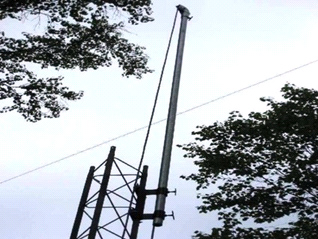
Gin-pole in place on a Rohn-25G tower section, notice the rope comes down through the pipe/ pole!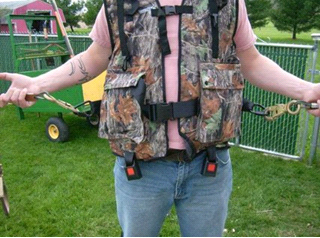
(Shown without crotch straps rigged)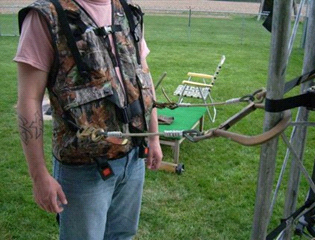
BlackHawk!™ Lanyard #990453OD
Safety requires a climber’s harness has independent (two) lanyards; it is essential the lanyards have self-locking Carabineer/hooks. Having independent Carabineer/hook lanyards will keep you attached to the tower at all times while you ascend, descend, or adjust your position.
http://www.service.kleintools.com/
http://www.blackhawk.com/product/Personal-Retention-Lanyard,1088,1390.htm
I had used a climbers ‘waste’ belt for years but it often would slide up my mid-section creating severe back strain. Upon returning to the Midwest and becoming an Ohio DNR Hunters Ed Instructor, this old dog learned a new trick. I acquired a full body tree-stand hunting harness that has a built-in waist-belt with D hooks for lanyards. This is by far much more comfortable and safer! My son is wearing my vest-harness for the pictures. This vest is similar to “Big Game® EZ – ON Safety Vest” a TMA-certified Safety Harness for ~$60 (what is your life worth?) http://www.sportsmansguide.com/net/cb/cb.aspx?a=991940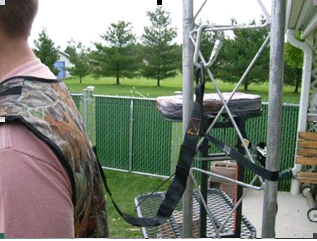
An added benefit of using a hunter’s tree-harness is it has a safety tether in the center backshoulders where a ‘real’ mountain climbers Carabineer is used to hook the harness onto a tower rung (or looped around a fat rung using the Carabineer to reattach to the strap).
As pictures the “Hunter Safety System® Carabineer” is an aluminum alloy rated to 5,600 lbs, w/large knurled auto-locking nut costs ~$10ea. Do NOT use cheap key-carabineers’ from hardware stores that are not rated for any real weight nor strength – what is your life worth? All Safety ‘Carabineers’ should meet or exceed ANSI Z359.1, CSA Z259.12-01, EN 362:2004B and 100% proof loaded to 3600 lbs, min breaking load >5000 lbs.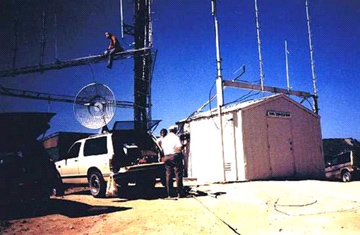
(That’s me sitting on the 20’ cross member of the 100’ tri-array)
[Side story: We started out on a bright sunny day in 1988, to install a 220 remote base repeater system on Sunset Peak 5,600ft (just below Mt Baldy 10,900 ft) above the San Gabriel Valley, CA. We were on a 100’ tri-tower complex for hours when unexpected weather blew in. We were caught in thick fog (low clouds) that zeroed our visibility of the ground crew and then it turned into a blowing rain then to snow (blizzard). Since I was the only one with a two lanyard-belt I sent the other two below. During my hour descent I had to install all the hard-line clips and by the time I got to the ground my right side was a sheet of snow/ice. Do you know how slippery soaked leather gloves become on freezing galvanized metal? I religiously and slowly descended one rung at a time always re-hooking into the tower after every rung! As they say _hit happens BUT we did not check the WX before climbing as it was bright-n-sunny when we arrived – see picture!]
From years of experience and lessons learned – I highly recommend climbing with good boots. Putting all your weight on the Rohn-25 quarter-inch wire rungs really hurts in a very short time. If you are working on Rohn towers you will want solid shank boots. Old style Vietnam jungle boots with punji-stake steel bottom inserts works fine and these boots are still relatively cheap through surplus stores. Rohn-45/55G rungs are not horizontal but angled making your foot slide to the tower sides wedging your foot becoming quickly uncomfortable and even slicing your boot soles. http:// www.armynavysuperstores.com/jboots.htm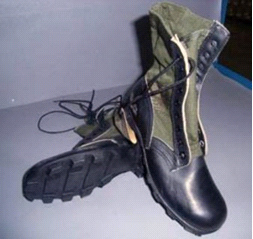
Never climb a tower without wearing leather gloves. The metal temperature can cause hand cramps, sliding your hands over metal burs will ruin your day, as well as bird stuff, rust, and flaking metal can make for slippery hand holds. Once you’re at the tower working position you may want to change your gloves to a thin rubberized skin workman’s type glove to improve your dexterity for tools/nuts/bolts!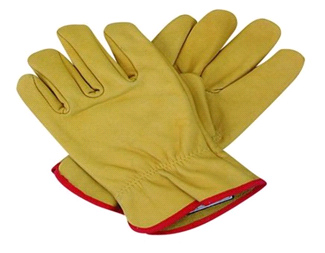
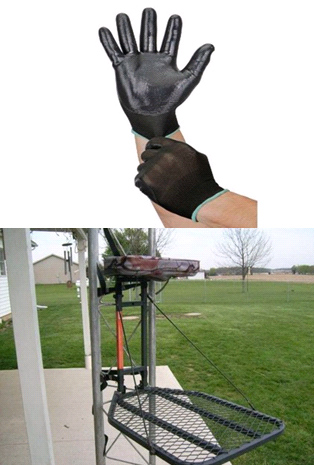 Since I’m not getting any younger (or lighter) I find tower work more tiring than 25yrs ago. Standing on tower rungs hurts in time even with solid shank boots. What is needed is a standing platform to ease my discomforts and prolong my time aloft. Most tower companies sell platforms but are cost prohibitive and the platforms have a very small foot area. Since I’m a hunter and hunting tree stands are made to hold me aloft for long periods I gave it a try. I bought an economical ~$50 tree stand, to be my tower platform and it even has a seat so I may take scenic rest breaks. It does not get much better when relaxing on your tower top looking at your installed antennas or taking in the local vistas!
Since I’m not getting any younger (or lighter) I find tower work more tiring than 25yrs ago. Standing on tower rungs hurts in time even with solid shank boots. What is needed is a standing platform to ease my discomforts and prolong my time aloft. Most tower companies sell platforms but are cost prohibitive and the platforms have a very small foot area. Since I’m a hunter and hunting tree stands are made to hold me aloft for long periods I gave it a try. I bought an economical ~$50 tree stand, to be my tower platform and it even has a seat so I may take scenic rest breaks. It does not get much better when relaxing on your tower top looking at your installed antennas or taking in the local vistas!
This may not be the conventional way of using a tree stand but the mechanics are nearly the same. If you decide to use a tree stand on Rohn-45/55G test it at ground level first to insure your tree clamping straps will reach and to verify your stand mounting strategy.
I placed the stand onto the Rohn tower and used a pre-sized bungee cord with hooks to temporarily hold the stand to the tower while I thread the retaining straps through the hand pump-lever winches. You MUST use both stand straps! The top will get most of the leverage from your weight but the bottom strap insures the stand will not kick out from the weight supporting rung. The straps only need to be snug but firmly in place to insure minimal movements of the stand. Beware of the platform cables as they can snag your boot – since you’re still harnessed in snagging this trip hazard should only momentarily get your heart to skip a few beats, but I’ll leave to your imagination what color your shorts have become.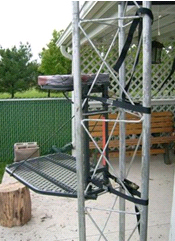
Notice the bottom of the stand platform bracket is resting on the tower wire rung.
NEVER drag equipment up with you while you’re ascending, it may get snagged in a tower rung and the extra weight will accelerate your climbing fatigue much faster. The only item you should bring up with you is a rope that will easily reach the ground.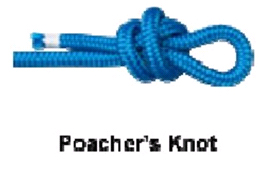
There are a few methods to rig a tender rope, the simplest is to use a tower rung but it creates a lot of rope friction so I made my own Tender rig (pictured above). A Harbor Freight big Carabineer attached to a simple plastic pulley that runs a >¼” rope. My tender rope has two Poacher’s knots, one on each rope end that is connected by the same Carabineer. The Carabineer allows easy attachment of a Home-Depot™ 5-gal tender bucket that will hoist all the tools/water/towels/etc aloft. This rope method makes a complete loop and allows the noload rope to be used as a guide-rope keeping the bucket from snagging the tower.
If I’m installing a rotor or needing to hoist items larger than my tender bucket I will install my Tender outrigger arm. The arm keeps the tender bucket/load away from the tower. This home-made arm is 2”x1/4” steel angle ‘L’ about 4’ long; holes are drilled to allow attaching ¼”x20 ‘U’ clamps (TV mast type) to the tower vertical pipes. I use ¼-20 wing nuts on the U clamps to lessen my tools aloft. The other end of the outrigger arm is a hole to hang the tender rig.
Remember, to ALWAYS have a guide rope on any load going aloft. The guide rope is used to keep the load away from the tower so nothing snags the tower, guy, or electrical wires – but remember to insure the climbers can untie the guide rope. I’ve seen guide rope attached to the reflector/boom end of a HF yagi beam to only discover there was no way to untie the rope when it was installed in place – this mistake usually only happens once!
There is ONLY one ground Commander while the monkey(s) are swinging on the tower, period! The Commander issues all hoisting commands (getting queues from the Lead Climber) while all others on the ground are quite mules. This is not the time to argue or have turf battles. During the pre-evolution Safety briefing a clear chain-of command was established! This may seem harsh and overly bearing but this tower evolution is all about success and SUCCESS MEANS SAFETY — a boisterous or arguing ground crew is unsafe!
In the purest of safety methods every tool has a tether string tied to it. But this is not practical. I found a different method – using two magnetic tool strip holders (bolted back to back) to easily hold tools aloft. I place the strip onto the tower and ONLY use it to hold my ‘actively’ in-use tools. (I move all unused tools to the tender-bucket as soon as possible.) Another handy use is to hold steel screws/bolts/nuts/washers until needed! http:// www.harborfreight.com/18-inch-magnetic-holder-65489.html ~$5ea.
ABSOLUTE RULES for ground crews are to wear eye protection; safety glasses are the best but sunglasses at a minimum. If you’re a ground crew member getting closer than 25’ to the tower you should wear hard a hat, as stuff falls much faster then you will hear someone screaming “incoming”. A falling tool can bounce off tower rungs and fly! CLIMBERS, if a tool (or anything) is dropped immediately scream “INCOMING” or the attention word(here is where a four letter word may be appropriate) to get all to look up and duck-n-cover.
Needless to say, beer/booze is for AFTER the climbers touch the ground!
I’m sure there are many more items to be considered, this article is only a starter to get you thinking. I hope this article helps your next tower-party; if it prevents an injury or saves a life it was worth my time in writing and your time in reading!
Writer BIO: Dale Kubichek, BS/MS-EET, GROL/RADAR, N6JSX – Amateur Extra; first licensed in 1972. Served 10yrs USN, Vietnam Vet, FTG1 Gun/Missile systems & electronics instructor. Electronics Test/MFG/QA Engineer & Program Manager, in; aerospace – Hughes, Northrop, Rockwell, HawkerBeechcraft; commercial – Magellan, Mitsubishi, Emerson-Copeland; heavy construction – TEREX, Manitowoc Cranes, Magnetek; communications – Hughes, STM, RockwellCollins. Currently, a USAF SPO Sr. Engineer on UAV SIMs. Interests are in designing/testing antennas, RDF hunting/training, SAT OPs; published numerous articles in 73 Magazine, eHAM.net, WI Badger Smoke Signals, HamUniverse.com.
Owner of:
http://groups.yahoo.com/group/HAM-SATs ,
http://groups.yahoo.com/group/RDF-USA , and many more.

